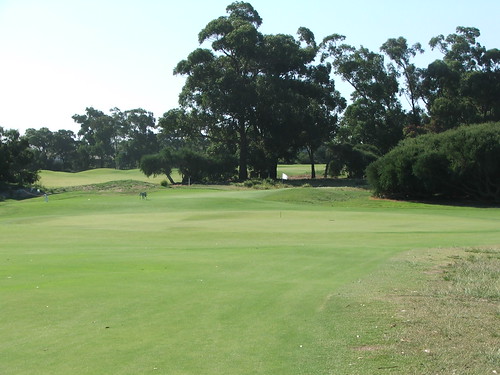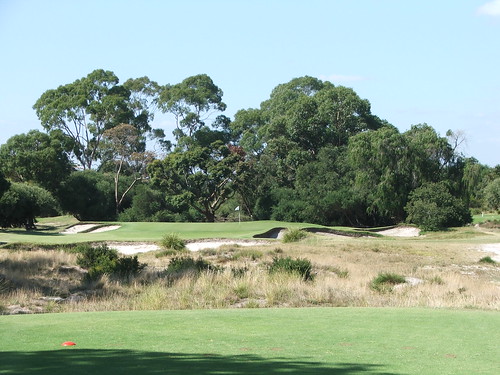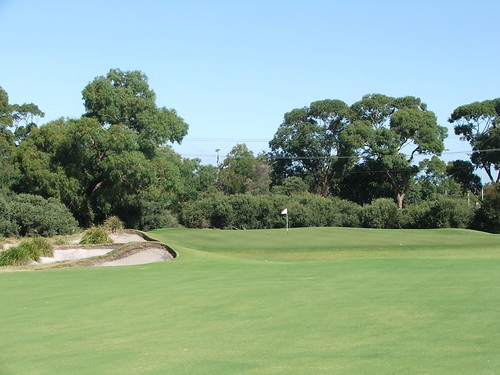
Kingston Heath Golf Club (ranked #21 in the world) is located in the sandbelt region of Melbourne and was designed in 1925 by Australian professional Dan Soutar. As was the practice at that time, bunkers were kept to a minimum when the course was built to see how it played and how the predominant winds blow. Soutar was paid a fee of 25 guineas plus traveling expenses from Sydney. He planned the course around the tenth hole, which is set among a picturesque avenue of gum trees. Soutar routed the course so you wouldn't have to play into the afternoon sun. The course was constructed by M.A. Morcom, who was the superintendent at Royal Melbourne.
While Alister MacKenzie was visiting Australia he was hired to offer suggestions on bunker placement. The course was 6,892 yards long when it opened, which is very long for the 1920s. In his 1926 report on the course, MacKenzie criticized it for being too long.

No drinks served at this 19th hole
We played Kingston Heath on a beautiful autumn day with perfect temperatures, no wind or clouds and no humidity. We played the course routing that is used when tournaments are played at Kingston Heath, including the routing Tiger Wood played last year when he won the Australian Masters. The course card was as follows:
Front nine: 1-19-12-13-14-15-16-17-18
Back nine: 7-8-9-11-2-3-4-5-6
The nineteenth hole is an alternate par three they use instead of the par three tenth hole. Kingston Heath is on very flat terrain and was easy to walk. The distinctive feature in my view are the bunkers. There are a lot of them; they are strategically placed and difficult. The greens and fairways are both relatively flat, but given the angle most bunkers are set at, it is hard to hold the ball on the green if you are coming out of the sand.
The book The World’s 500 Toughest Golf Holes ranks the first at Kingston Heath among its holes. The hole is 418 meters (add 10 percent for yards) and was originally a par five. The tee shot must be played up and over a hill with bunkers dramatically cut into its right side.
The Australian and five-time British Open Champion Peter Thomson is a big fan of the third hole, which is an 269 meter yard par four. He says, "holes of this length are not built any more - a pity. This one is a gem. In this day and age it can be driven, although the possibility must be ten or more to one against. For this reason the penalties for missing the target should be more severe, this enhancing the challenge."
Planet Golf also feels that the best hole of all at Kingston Heath is the drivable but dangerous third because the shallow green is angled to accept only the most precise pitch shots.
Thompson is also a big fan of the fifth hole, a 173 meter par three. “The threes here at Kingston Heath are very much the heart of the course, and this one is the first of three beauties. The original natural bumps and hollows have been preserved blessedly."

Tiger Woods, 13th hole (11th on card), Kingston Heath 2009
As is typical here, the green is cut at a right angle up to the edge of the bunker, leaving zero margin for error. The fourteenth green has some very artful bunkering and is one of the few greens with larger undulations.
Thompson says fourteen is one of the best par fives in Australia. My favorite stretch of holes was thirteen through seventeen. The fifteenth hole, a par three of 142 meters was my favorite. It plays uphill and is well bunkered as seen in the picture. The fifteenth hole was originally a 222 yard par three with a blind green sloping away from the line of play. Tom Doak says that MacKenzie built this hole himself. Planet Golf calls the fifteenth the star attraction at Kingston Heath, and it surely is.
The finish at Kingston Heath is a difficult one. The seventeenth is a long and hard hole at 421 meters. The second shot is blind and as such there are no fairway bunkers.

Approach to the bunkerless seventeenth green
The nineteenth hole is a nice par three. On this hole I was introduced to the two crazy Kiwis who are playing a round of golf every day of the year in 2010 throughout the world. Their compelling story is here. We had a nice chat with them, and they came away with the impression that we were a couple of American "high flyers," which I kinda like.
Tom Doak compares Kingston Heath to Merion in that it is a strategic design on a tight piece of land and has a similar great use of only about 125 acres. Combined with the intricate bunkering, it makes a compelling golf course.
The month I played Kingston Heath, Golf Digest Australia ranked the course above Royal Melbourne as the best course in the country for the first time. I don’t agree and think the composite at Royal Melbourne is better. I would also rank New South Wales, Barnbougle Dunes and Royal Adelaide above Kingston Heath. The Golf Digest Australia 2010 rankings: 1. Kingston Heath, 2. New South Wales, 3. Royal Melbourne West, 4. Barnbougle Dunes, 5. Ellerston, 6. The National (Moonah), 7.Metropolitan, 8. Royal Melbourne East and 9. Royal Adelaide.
As with all the great courses in Australia, they welcome overseas visitors as long as you follow their rules. It is easy to email them and arrange a day to play. You are made an honorary member for the day with all the club privileges. As with all the clubs we visited in Australia, we were treated very well at Kingston Heath. The club itself has the feel of a proper old English club. I wish I had scheduled more time in the sandbelt region, having missed playing Yara Yara, Metropolitan and the many other great courses here.
Melbourne
 The Melbourne University Boat House on the Yarra River
The Melbourne University Boat House on the Yarra River Melbourne is a delightful city with a river running through it crammed with a lot of little back alleys and lanes where you can sit outside in a café or have a drink. After the round, we rode back to the airport. Our driver took us along Melbourne Bay and the upscale Brighton and St. Kilda neighborhoods, beside the beach and waterfront. Imagine living along the waterfront here, commuting to downtown Melbourne on a tram and playing all these wonderful sandbelt courses on a regular basis. A good deal, if you can get it. These Aussies have some lifestyle.
 Central Melbourne
Central Melbourne For the record, Australia has the best air transport system in the world. As an example, Melbourne is a city of four million people, or a little smaller than Chicago. It took us about five minutes to go through airport security each time we traveled. We flew through Sydney, Melbourne, Adelaide and Launceston, and all are airy and clean airports and offer little stress to the haggard traveler. You don’t have to take your shoes off, you can carry through liquids and you are not presumed to be a criminal as you are in the United States. They allow non-travelers to come right up to the gate, thus the lost pleasure of having kids run up to their parents, or your mother-in-law greeting you with open arms when getting off a plane, still exists in Australia.
It helps that all the principal cities in Australia have great weather all year round, the country is geographically the size of the U.S. with 20 million people, and they are so far away that they aren't a terrorism target. Thankfully, the scourge of CNN Airport Network also hasn't infected Australia so you can sit at the gate without being barraged by noise pollution. Still, it’s just nice to remember that airline travel doesn't have to be painful.





No comments:
Post a Comment